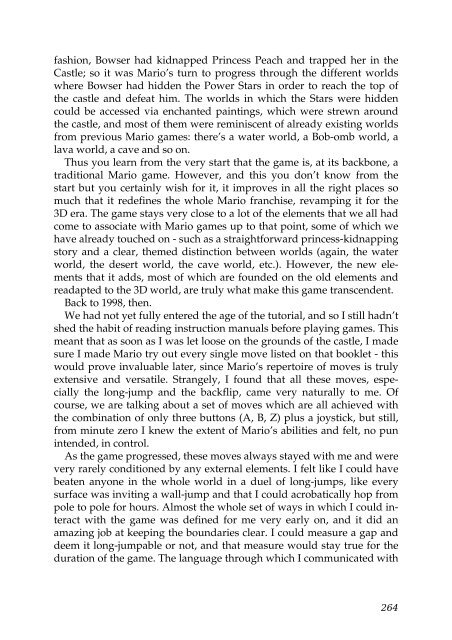Well Played 2.0: Video Games, Value and Meaning - OpenLibra
Well Played 2.0: Video Games, Value and Meaning - OpenLibra
Well Played 2.0: Video Games, Value and Meaning - OpenLibra
Create successful ePaper yourself
Turn your PDF publications into a flip-book with our unique Google optimized e-Paper software.
fashion, Bowser had kidnapped Princess Peach <strong>and</strong> trapped her in the<br />
Castle; so it was Mario’s turn to progress through the different worlds<br />
where Bowser had hidden the Power Stars in order to reach the top of<br />
the castle <strong>and</strong> defeat him. The worlds in which the Stars were hidden<br />
could be accessed via enchanted paintings, which were strewn around<br />
the castle, <strong>and</strong> most of them were reminiscent of already existing worlds<br />
from previous Mario games: there’s a water world, a Bob-omb world, a<br />
lava world, a cave <strong>and</strong> so on.<br />
Thus you learn from the very start that the game is, at its backbone, a<br />
traditional Mario game. However, <strong>and</strong> this you don’t know from the<br />
start but you certainly wish for it, it improves in all the right places so<br />
much that it redefines the whole Mario franchise, revamping it for the<br />
3D era. The game stays very close to a lot of the elements that we all had<br />
come to associate with Mario games up to that point, some of which we<br />
have already touched on - such as a straightforward princess-kidnapping<br />
story <strong>and</strong> a clear, themed distinction between worlds (again, the water<br />
world, the desert world, the cave world, etc.). However, the new elements<br />
that it adds, most of which are founded on the old elements <strong>and</strong><br />
readapted to the 3D world, are truly what make this game transcendent.<br />
Back to 1998, then.<br />
We had not yet fully entered the age of the tutorial, <strong>and</strong> so I still hadn’t<br />
shed the habit of reading instruction manuals before playing games. This<br />
meant that as soon as I was let loose on the grounds of the castle, I made<br />
sure I made Mario try out every single move listed on that booklet - this<br />
would prove invaluable later, since Mario’s repertoire of moves is truly<br />
extensive <strong>and</strong> versatile. Strangely, I found that all these moves, especially<br />
the long-jump <strong>and</strong> the backflip, came very naturally to me. Of<br />
course, we are talking about a set of moves which are all achieved with<br />
the combination of only three buttons (A, B, Z) plus a joystick, but still,<br />
from minute zero I knew the extent of Mario’s abilities <strong>and</strong> felt, no pun<br />
intended, in control.<br />
As the game progressed, these moves always stayed with me <strong>and</strong> were<br />
very rarely conditioned by any external elements. I felt like I could have<br />
beaten anyone in the whole world in a duel of long-jumps, like every<br />
surface was inviting a wall-jump <strong>and</strong> that I could acrobatically hop from<br />
pole to pole for hours. Almost the whole set of ways in which I could interact<br />
with the game was defined for me very early on, <strong>and</strong> it did an<br />
amazing job at keeping the boundaries clear. I could measure a gap <strong>and</strong><br />
deem it long-jumpable or not, <strong>and</strong> that measure would stay true for the<br />
duration of the game. The language through which I communicated with<br />
264

















